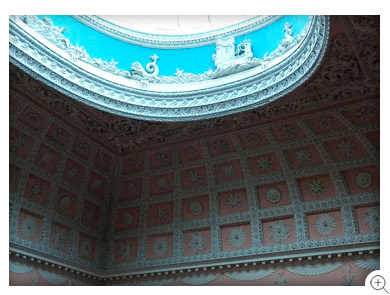Externally Claydon House in Buckinghamshire is a rather sober place. Its symmetrical west front of seven bays in cut stone suggests conformity to an austere Georgian style of architecture - and no bad thing. Inside, however, if there is such a thing as high rococo, its most extreme form is to be found here at Claydon. Take your smelling salts! You have been warned!
What’s inside Claydon is both bizarre and wonderful. Spiritual cousin to Brighton’s Royal Pavilion, it’s an opium den vision of impossibly flamboyant detail. High ceilings have elaborately-moulded domes - often in wood rather than plaster; chimney-pieces have overmantels that rampage outwards; niches and mirrors are bedecked with ho-ho birds, urns and swags; walls curve towards the ceilings they support using friezes of winged putti heads. Flowers and garlands abound. A magnificent mahogany marquetry staircase with a black and gold balustrade of great beauty is too fragile to be used by the public. Various rooms lie empty; a museum crammed to bursting, which houses the family’s collection of curiosities, is on the top floor. An upstairs Chinese room has a wildly elaborate alcove. It’s extraordinary, exuberant and exquisite. The craftsmanship on display is of the highest order. There is nothing like this anywhere else in Britain. Claydon is a Grade I listed building, and so it should be.
When it was being re-built in the mid-1700s, Claydon was an attempt to rival nearby Stowe. The project took off with such velocity that it nearly broke the owner and resulted in his niece demolishing two-thirds of it to save money. What one sees today is what is left. Every inch of the place is a delight. Go there!
Claydon House, stairwell skylight ringed with nautically-themed wood carvings, supported on deep plaster coffering
Claydon House, the carved alcove in the Chinese room, arguably laying claim to be the most extraordinary room in the country













